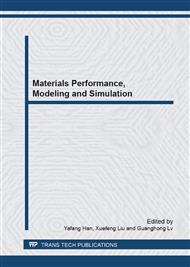p.168
p.173
p.180
p.187
p.192
p.198
p.205
p.211
p.217
Magnetic Properties and Morphology of the Cobalt Particles Prepared in Different Liquid Solvent
Abstract:
The two kinds of flower-like ultrafine cobalt particles were prepared by reducing cobalt chloride (CoCl2·6H2O) with hydrazine hydrate (N2H4·H2O) under ultrasonic and microwave radiation, in which ethanol-water or ethylene glycol-water mixture was used as solvent. The morphology, crystal structure and magnetic properties of the as-prepared particles were characterized by scanning electron microscope (SEM), x-ray diffraction pattern (XRD) and vibrating sample magnetometer (VSM). The results show that the petals of the flower-like cobalt particles prepared in the ethanol-water system were dendritic, while the petals of the flower-like cobalt particles prepared in the ethylene glycol-water system were sword-like. The crystal structure of cobalt particles prepared in the two kinds of systems both consisted of hexagonal close-packed cubic phase and face-centered cubic phase, but the relative content was different. The saturation magnetization of the cobalt particles with dendritic petals and the cobalt particles with sword-like petals was the same approximately, but their coercivity was greatly different (the difference in value about 7184.14Am-1), which might be attributed to the magnetocrystalline anisotropy and shape anisotropy.
Info:
Periodical:
Pages:
192-197
Citation:
Online since:
March 2013
Authors:
Keywords:
Price:
Сopyright:
© 2013 Trans Tech Publications Ltd. All Rights Reserved
Share:
Citation:


